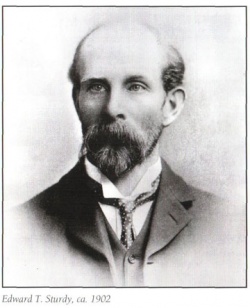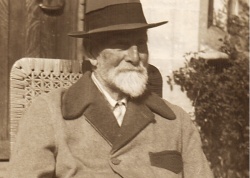E. T. Sturdy
Edward Toronto Sturdy (1860 – March 15, 1957) was a Sanskrit scholar, student of Hinduism and Buddhism, and a member of the Theosophical Society. He was part of the Inner Group formed by H. P. Blavatsky and the one who recorded what is today known as HPB's Diagram of Meditation.
Theosophical involvement
E. T. Sturdy went to New Zealand at the age of 19. A few years later, in 1884, he heard about the Theosophical Society through a friend and sent a letter to Adyar. He joined the Society in October 1885, with only eight New Zealanders having done this before him.[1] The next year he went to India and around March, 1887, joined for a few days H. S. Olcott who was on a tour in Northwest India. Then, he left for Ceylon to attend some Society's business.[2] He then went to London and met H. P. Blavatsky, who had just moved there in May. It may be at this time that she dictated to him her Diagram of Meditation.
Mr. Sturdy returned to New Zealand by way of New York where he met W. Q. Judge. He settled in Wellington and gathered some students around, which eventually lead to the formation of the first lodge in the country, the Wellington Lodge, chartered in November 1888:
Among its members were Sir Harry Albert ATKINSON, Prime Minister of New Zealand; his wife Anne E. Atkinson; their son, E. Tudor Atkinson; M. van Staveren, a Jewish rabbi; H. M. Stowell (Hare Hongi), a Maori tohunga (priest); and Edward Tregear, a poet and Maori scholar, who wrote a book about the similarities of the Hindu and Maori languages.[3]
Mr. Sturdy left for England in December 1888 to become a student of Mme. Blavatsky, and after his departure the Wellington Lodge ceased to exist (it was rechartered in 1894).
He became a member of the Esoteric Section of Theosophy and one of the "E.S.T. Council" appointed by H.P.B. He was also part of the European Advisory Council formed in July, 1890, to assist her in her new function as the Presidential authority of the Theosophical Society in Europe. The other members of the Council were Annie Besant, W. Kingsland, Herbert Burrows, A. P. Sinnett, H. A. W. Coryn, and G. R. S. Mead.[4]
Mr. Sturdy was also a member of the Inner Group formed by HPB in August 1890. Many years later, in 1947, he wrote: "I think I must have been the most skeptical of all the members of HPB's Inner Group". He then proceeds to say that in time he had come to believe in Mme. Blavatsky and also in the Masters of Wisdom as "concrete individuals" and not only as ideals.[5]
On April, 1891, ill and few weeks before dying, HPB was concerned that Mr. Sturdy had also been taken ill with influenza. When it was suggested that Mr. Mead should bring him to be nursed at Headquarters, she was much pleased and insisted on his being sent for at once.[6]
Mr. Sturdy was present at the meeting at 19 Avenue Road on May 27, 1891, when the E.S. was reorganized immediately after the death of H.P.B.
In August 1893 he published an article on Gurus and Chelas in Lucifer. The latter induced Annie Besant to publish another article in October, 1893, taking a stand against the spirit behind Mr. Sturdy's.
He was actively involved in the controversy that lead to the secession of the American Section of the Theosophical Society lead by Mr. Judge.
In the later part of his life he had stopped having any dealings with the Theosophical Society.
Eastern philosophy
Theosophy was not his only inspiration. In 1940 he wrote: "What I have, I owe largely to H. P. Blavatsky, to some extent to Anna Kingsford and Edward Maitland, and perhaps, most of all, to the Vedanta and Buddhist teachings".[7] In 1947 he wrote to Boris de Zirkoff:
Although I often refer to The Secret Doctrine, I am not so much of an Occultist, which HPB undoubtedly was, as a Mystic and follow in thought and effort the teachings of the Advaita Vedānta and Mahāyāna Buddhism.[8]
During the latter part of 1893, Mr. Sturdy met Swami Shivananda. In 1895 Swami Vivekananda had been planning a visit to London for some time. Miss Henrietta Müller, who had already met him in America, extended to him an invitation to come to London, and Mr. E. T. Sturdy had requested him to stay at his home there.[9] Vivekananda gave a lecture October 22, 1895, at Prince’s Hall, of which Mr. Sturdy was the Chairman.[10] Eventually, Swami Vivekananda and Mr. Sturdy began to work together on an English translation of the Bhakti aphorisms of Narada. After a two months' stay in England, before leaving, he arranged that Mr. Sturdy should conduct classes in London till the arrival of a new Swami from India.
Another testimony of his pursue of Eastern philosophy comes from the writer Lafcadio Hearn (a.k.a. Koizumi Yakumo) who wrote to a friend in April, 1898:
I have met a most extraordinary man. . . . His name is E. T. Sturdy. He has lived in India --up in the Himalayas for years-- studying Eastern philosophy; and the hotel delicacies will do him no good, because he is a vegetarian. He is a friend of Professor Rhys-Davids, who gave him a letter of introduction to me; and has paid for the publication of several Eastern texts--Pali, etc. Beyond any question, he is the most remarkable person I have met in Japan. Fancy a man independent, strong, cultivated, with property in New Zealand and elsewhere, voluntarily haunting the Himalayas in the company of Hindoo pilgrims and ascetics,--in search of the Nameless and the Eternal. Yet he is not a Theosophist exactly, nor a Spiritualist. I did not get very near him--he has that extreme English reserve which deludes under the appearance of almost boyish frankness; but I think we might become fast friends did we live in the same city. He told me some things that I shall never forget,--very strange things.[11]
Norburton Hall
Later years
In a letter to Boris de Zirkoff dated 18 April, 1947, he writes: "I am the last of all her Inner Group. I live almost the life of a hermit, for my contact with the outer world is almost entirely by letters".[12]
In March 13, 1957, Mr. Sturdy had a slight stroke from which he recovered. However two days later, on March 15, he passed on suddenly after lunch "without even a sigh", aged 97. It is reported he was reading an article on life after death in Buddhist thought by his friend Christmas Humphreys.
Online resources
Articles and pamphlets
- Gurus and Chelas by E. T. Sturdy and a reply by Annie Besant
- Reminiscences of Swami Vivekananda by E. T. Sturdy
- Letters from Swami Vivekananda to Mr. E. T. Sturdy, April 24, 1895 and September 14, 1899.
- Norburton Hall at DorsetLife
- The Story of Norburton Hall at Burtonbradstock Online
- Norburton Hall History at NorburtonHall.com
Notes
- ↑ Robert S. Ellwood, Islands of the Dawn, (Honolulu: University of Hawaii Press, 1993), 98-99.
- ↑ Henry Steel Olcott, Old Diary Leaves Third Series (Adyar, Madras: The Theosophical Publishing House, 1974), 422-423.
- ↑ Philip Harris, Theosophical Encyclopedia (Quezon City: Theosophical Publishing House, 2006), 449.
- ↑ Helena Petrovna Blavatsky, Collected Writings vol. XII (Wheaton, IL: Theosophical Publishing House, 1980), 264.
- ↑ Personal letter to Boris de Zirkoff written in Norburton, 18 April 1947, kept in the Archives of the Theosophical Society in America.
- ↑ How She Left Us by Laura M. Cooper.
- ↑ Robert S. Ellwood, Islands of the Dawn, (Honolulu: University of Hawaii Press, 1993), 98.
- ↑ Personal letter to Boris de Zirkoff written in Norburton, 18 April 1947, kept in the Archives of the Theosophical Society in America.
- ↑ See Vivekananda - A Biography, Ch. 9, "Experiences In The West" by Swami Nikhilananda
- ↑ Henry Steel Olcott, Old Diary Leaves Fifth Series (Adyar, Madras: The Theosophical Publishing House, 1975), 404.
- ↑ Elizabeth Bisland, The Life and Letters of Lafcadio Hearn, Volume 2 (Boston: Adamant Media Corporation, 2006), 380.
- ↑ Personal letter to Boris de Zirkoff kept in the Archives of the Theosophical Society in America.

